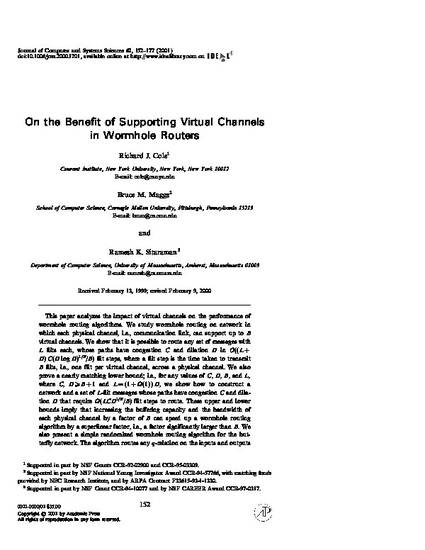
Presentation
On the Benefit of Supporting Virtual Channels in Wormhole Routers
8th Annual ACM Symposium on Parallel Algorithms and Architectures (SPAA)
(1996)
Abstract
This paper analyzes the impact of virtual channels on the performance of wormhole routing algorithms. We study wormhole routing on network in which each physical channel, i.e., communication link, can support up to B virtual channels. We show that it is possible to route any set of messages with L flits each, whose paths have congestion C and dilation D in O((L+ D) C(D log D)1_B_B) flit steps, where a flit step is the time taken to transmit B flits, i.e., one flit per virtual channel, across a physical channel. We also prove a nearly matching lower bound; i.e., for any values of C, D, B, and L, where C, D_B+1 and L=(1+0(1)) D, we show how to construct a network and a set of L-flit messages whose paths have congestion C and dilation D that require 0(LCD1_B_B) flit steps to route. These upper and lower bounds imply that increasing the buffering capacity and the bandwidth of each physical channel by a factor of B can speed up a wormhole routing algorithm by a superlinear factor, i.e., a factor significantly larger than B. We also present a simple randomized wormhole routing algorithm for the butterfly network. The algorithm routes any q-relation on the inputs and outputs of an n-input butterfly in O(L(q+log n) log1_B n log log(qn)_B) flit steps. We present a nearly-matching lower bound that holds for a broad class of algorithms.
Disciplines
Publication Date
June, 1996
Citation Information
Richard J. Cole, Bruce M. Maggs and Ramesh Sitaraman. "On the Benefit of Supporting Virtual Channels in Wormhole Routers" 8th Annual ACM Symposium on Parallel Algorithms and Architectures (SPAA) (1996) Available at: http://works.bepress.com/ramesh_sitaraman/15/
